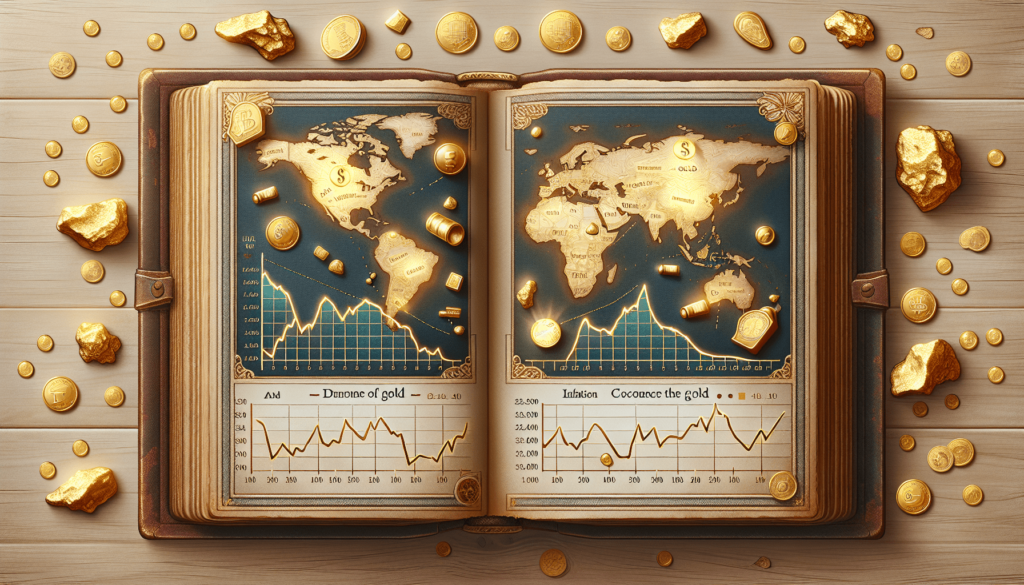Whether it’s a recession, a financial crisis, or a global pandemic, gold has consistently played a pivotal role in helping economies bounce back. In this article, we explore several case studies that highlight the undeniable impact of gold on economic recoveries. From the gold rushes of the past to the intricate dynamics of gold prices today, we’ll uncover how this precious metal has proven its worth time and time again in guiding countries towards stability and prosperity. So sit back, and discover the fascinating stories behind gold’s crucial role in shaping the world’s economic landscape.

Introduction
Welcome to this comprehensive article on the role of gold in economic crises and monetary policy. In this article, we will explore the historical background of gold as a store of value and medium of exchange. We will also analyze how gold has performed during major economic crises such as the Great Depression, the Global Financial Crisis, and the COVID-19 pandemic. Furthermore, we will delve into gold’s influence on investor behavior, its role as a safe haven asset, and its ability to hedge against inflation. Additionally, we will examine case studies of the Great Depression, the Global Financial Crisis, and the COVID-19 pandemic to further understand gold’s impact on economic recoveries. Finally, we will discuss the policy implications of gold, including its role in central bank reserves, potential for gold-backed currencies, and investment strategies. Let’s begin our exploration of the fascinating relationship between gold and the economy.
Historical Background
Gold as a Store of Value
Gold has a long history as a valuable and reliable store of wealth. Dating back to ancient civilizations, gold was prized for its scarcity, durability, and universal acceptance. Throughout the ages, gold has been used by individuals and societies to preserve their wealth. From the pharaohs of Egypt to the kings and queens of Europe, gold has played a significant role in maintaining financial security. Its intrinsic value and physical form make it a tangible asset that can be stored and preserved over long periods of time.
Gold as a Medium of Exchange
In addition to its role as a store of value, gold has also served as a medium of exchange in countless economies. Before the advent of fiat currencies, gold was often used to facilitate trade and commerce. Its scarcity and desirability made it a universally accepted form of payment. The concept of using gold as money can be traced back to ancient Mesopotamia, where gold was fashioned into standardized units of weight and used for commercial transactions. These gold coins became the foundation of many early monetary systems, establishing gold’s reputation as a reliable medium of exchange.
Gold’s Performance during Economic Crises
Great Depression
The Great Depression, a severe worldwide economic downturn that lasted from 1929 to 1939, was a pivotal moment in history that tested the resilience of various assets, including gold. As the stock market crashed and economies contracted, many investors turned to gold as a safe haven. The price of gold soared during this period, reflecting its ability to retain value in times of economic uncertainty. Governments around the world also recognized gold’s importance and implemented measures to stabilize their currencies based on gold reserves.
Global Financial Crisis
The Global Financial Crisis of 2007-2008 was another significant test for gold as an investment. As the banking system teetered on the edge of collapse and stock markets plummeted, investors once again sought the safety of gold. The price of gold surged to record highs, reaffirming its status as a reliable asset during times of financial turmoil. Moreover, central banks increased their gold holdings, recognizing its stability during times of crisis.
COVID-19 Pandemic
The COVID-19 pandemic, which began in 2019 and swept across the globe, affected economies in unprecedented ways. As uncertainty and fear gripped financial markets, gold once again emerged as a safe haven for investors seeking stability. The price of gold reached new highs, driven by a surge in investor demand and central banks adopting accommodative monetary policies. The COVID-19 pandemic further demonstrated gold’s strength as a hedge against economic uncertainties.
Gold’s Role in Monetary Policy
Gold Standard
In the past, gold played a central role in the monetary systems of many countries through the gold standard. Under the gold standard, the value of national currencies was tied to a fixed amount of gold. This system provided stability and confidence in currencies, as it ensured that money could be exchanged for a fixed amount of gold. The gold standard helped prevent excessive inflation and promoted trust in national currencies, as the value of money was directly linked to a tangible asset.
Bretton Woods System
Following the decline of the gold standard, the Bretton Woods system was established after World War II to stabilize global currencies. Under this system, the U.S. dollar was pegged to gold, while other currencies were pegged to the U.S. dollar. This indirectly linked these currencies to gold. However, the Bretton Woods system eventually collapsed due to economic imbalances and the depletion of U.S. gold reserves.
Current Monetary Policies
Today, most countries have moved away from the gold standard and adopted fiat currencies, which are not backed by a specific commodity. Central banks now have the flexibility to implement monetary policies such as quantitative easing and interest rate adjustments to manage their economies. However, gold still plays a role in the monetary policies of some countries, with central banks continuing to hold significant gold reserves as a form of insurance against economic uncertainties.

Gold’s Influence on Investor Behavior
Safe Haven Asset
Gold has long been considered a safe haven asset, sought after by investors in times of economic and political instability. When markets become volatile or geopolitical tensions rise, investors often flock to gold as a way to preserve and protect their wealth. The perception of gold as a safe haven is rooted in its historical role as a store of value and its ability to retain its purchasing power over time.
Portfolio Diversification
Another reason investors turn to gold is for portfolio diversification. Gold has a low correlation to other asset classes such as stocks and bonds, meaning its price movements are often independent of other investments. By including gold in a diversified portfolio, investors can potentially reduce overall risk and enhance long-term returns.
Hedge against Inflation
Inflation erodes the purchasing power of money over time, and gold has historically been seen as a hedge against inflation. As the price of goods and services rise, the value of gold tends to increase as well. This relationship between gold and inflation stems from the belief that gold’s scarcity and limited supply make it a reliable store of value when fiat currencies experience significant inflationary pressures.
Case Study 1: The Great Depression
Economic Background
The Great Depression was triggered by the stock market crash of 1929, causing widespread unemployment, bank failures, and a decline in industrial production. The economic downturn was characterized by deflation, falling prices, and a dramatic contraction in economic activity. The financial system was severely impacted, and people’s confidence in banks and the economy plummeted.
Gold’s Role in the Recovery
During the Great Depression, gold played a vital role in stabilizing economies and restoring confidence. The U.S. government implemented measures to increase the price of gold, which in turn helped to increase the money supply and encourage spending. By pegging the value of gold to the U.S. dollar, the government aimed to restore confidence in the financial system and promote economic recovery.
Case Study 2: Global Financial Crisis
Causes and Consequences
The Global Financial Crisis resulted from a combination of factors, including excessive risk-taking by financial institutions, the bursting of the housing bubble, and a lack of regulation in the financial sector. The crisis led to the collapse of major financial institutions, a global recession, and wide-scale unemployment. Governments and central banks around the world intervened to stabilize the financial system and stimulate economic growth.
Gold’s Performance and Impact
During the Global Financial Crisis, gold performed exceptionally well, providing a safe haven for investors amidst the turmoil. As stocks and other assets plummeted, the price of gold surged, reaching record highs. This surge in gold prices reflected a flight to safety, as investors sought the stability and reassurance that gold provided during the crisis. Furthermore, central banks recognized the importance of gold as a monetary asset and increased their holdings in response to the crisis.
Case Study 3: COVID-19 Pandemic
Economic Impact of the Pandemic
The COVID-19 pandemic caused widespread economic disruption, including lockdowns, supply chain disruptions, and a sharp decline in consumer spending. Businesses were forced to close, and millions of people lost their jobs. Governments implemented unprecedented stimulus measures to mitigate the economic fallout and support struggling industries.
Gold’s Performance and Role
In the face of economic uncertainty during the COVID-19 pandemic, gold once again demonstrated its value as a safe haven asset. As investors sought refuge from volatile markets, the price of gold soared to new heights. The pandemic highlighted gold’s ability to retain value and act as a reliable store of wealth during times of crisis. Additionally, central banks around the world implemented expansionary monetary policies, leading to increased demand for gold as a potential hedge against inflation.
Policy Implications
Central Bank Reserves
Gold still plays a significant role in central bank reserves today. Many countries view gold as a critical asset to diversify their reserves and manage risks. Central banks carefully consider the balance between holding gold and other assets, taking into account factors such as economic stability, international confidence, and potential currency fluctuations.
Gold-backed Currencies
The idea of gold-backed currencies has been proposed as a way to enhance monetary stability. A gold-backed currency would be directly convertible into a fixed amount of gold, providing confidence and stability in the currency’s value. However, the practical implementation of a gold-backed currency raises challenges and considerations, including the availability of gold reserves, the impact on monetary policy, and managing currency supply.
Investment Strategies
Investors have various strategies for including gold in their portfolios. Some choose to allocate a portion of their portfolio to physical gold in the form of bullion or coins, while others prefer to invest in gold exchange-traded funds (ETFs) or gold mining companies. The optimal allocation to gold depends on individual investment goals, risk tolerance, and market dynamics.
Conclusion
Gold’s significance in the world of economics and finance is undeniable. Throughout history, gold has served as a store of value, a medium of exchange, and a safe haven asset. Its performance during major economic crises such as the Great Depression, the Global Financial Crisis, and the COVID-19 pandemic has solidified its reputation as a reliable investment during times of turmoil. While the gold standard may no longer dominate monetary systems, gold continues to play a role in central bank reserves and investor portfolios. As the global economy evolves, the role of gold in monetary policy and its influence on investor behavior will continue to shape economic recoveries and financial decision-making.

